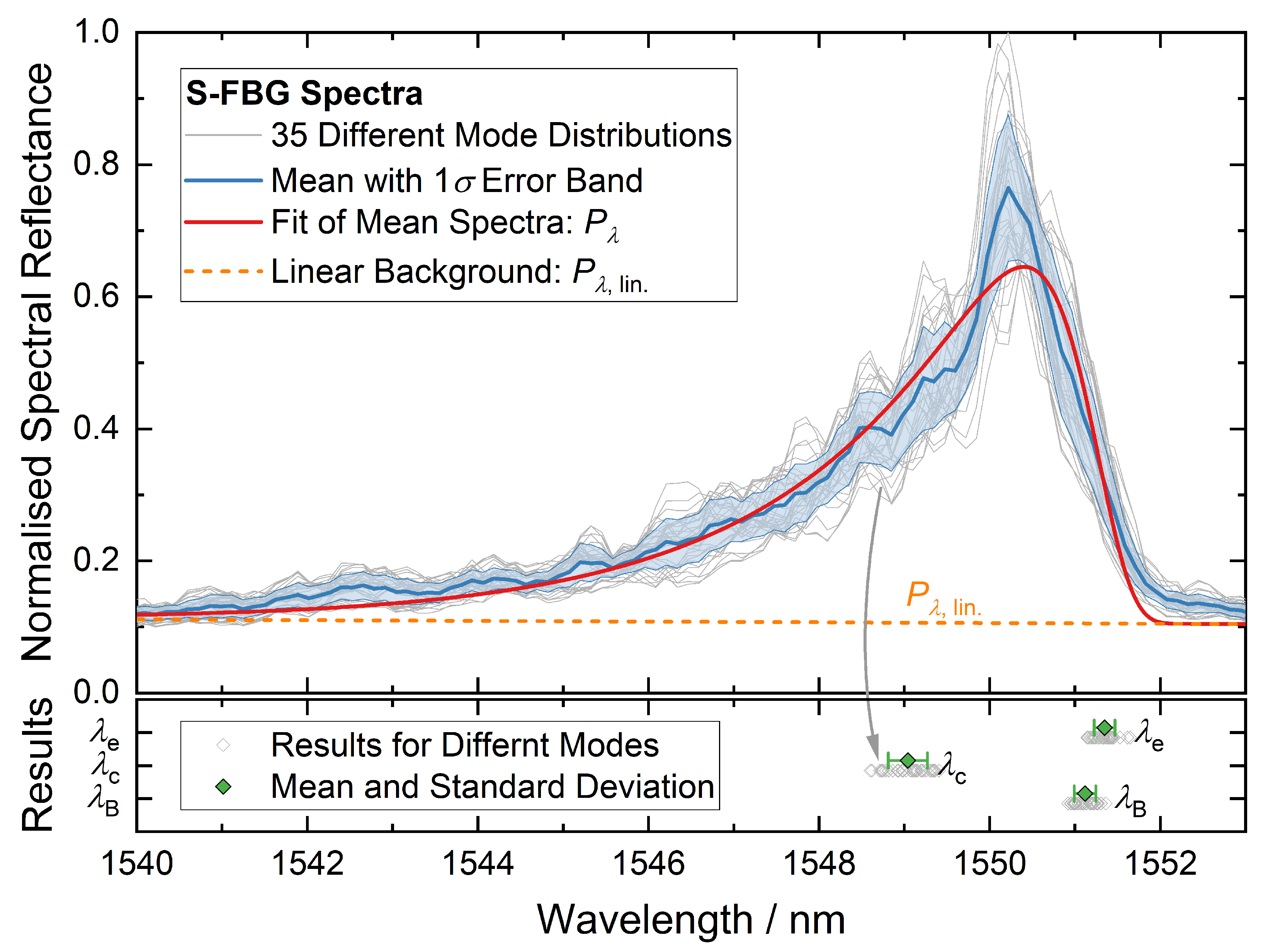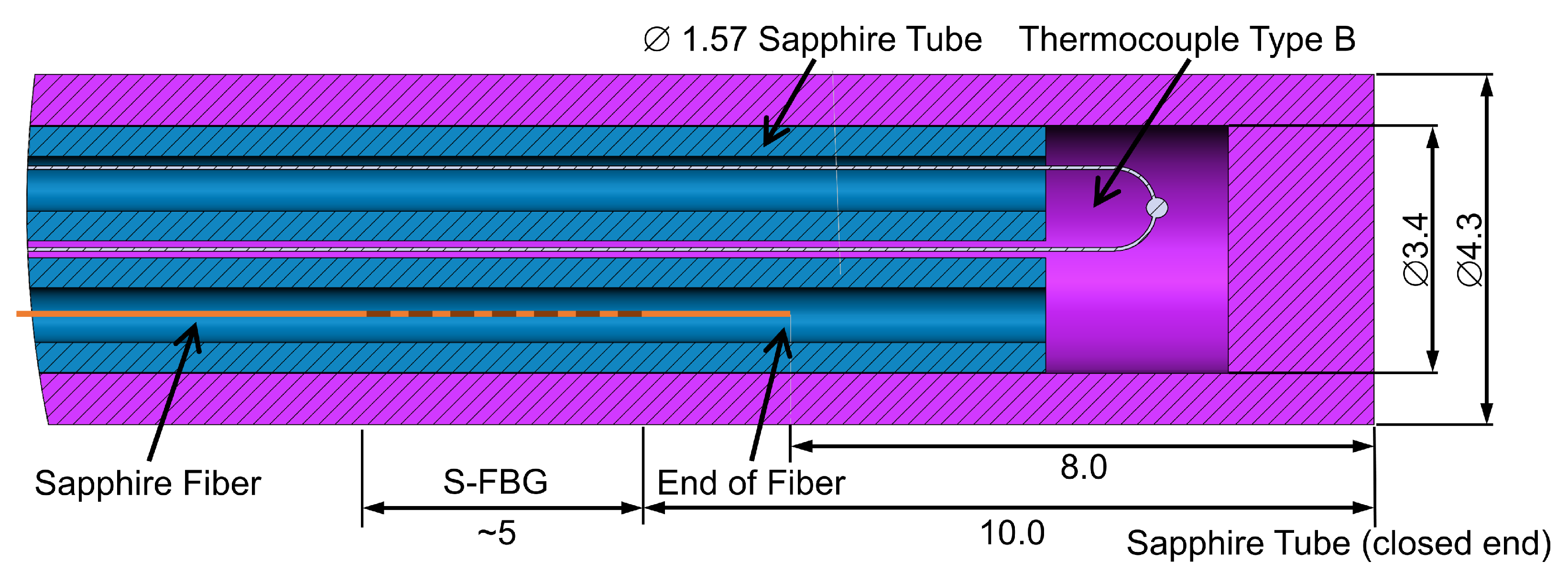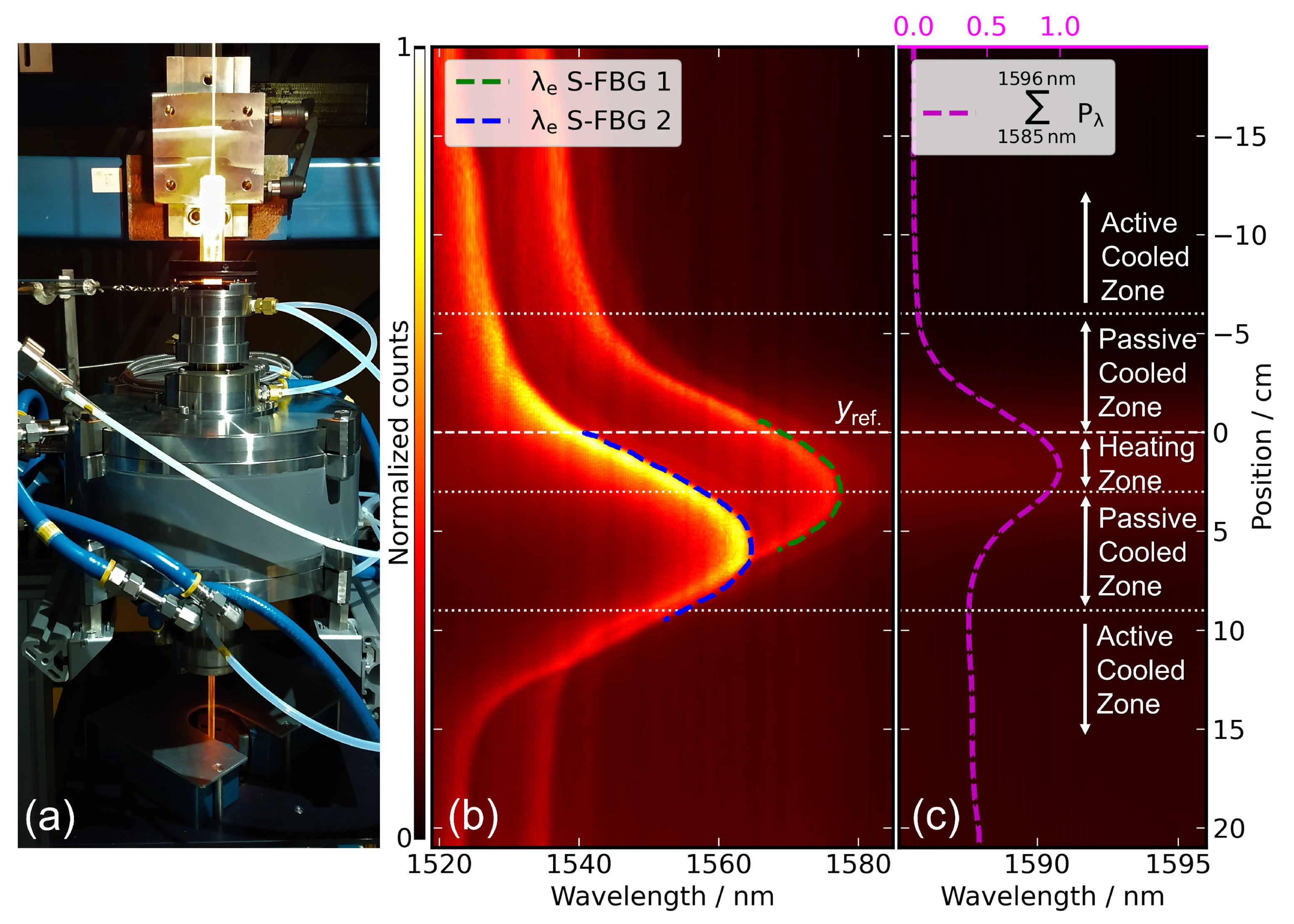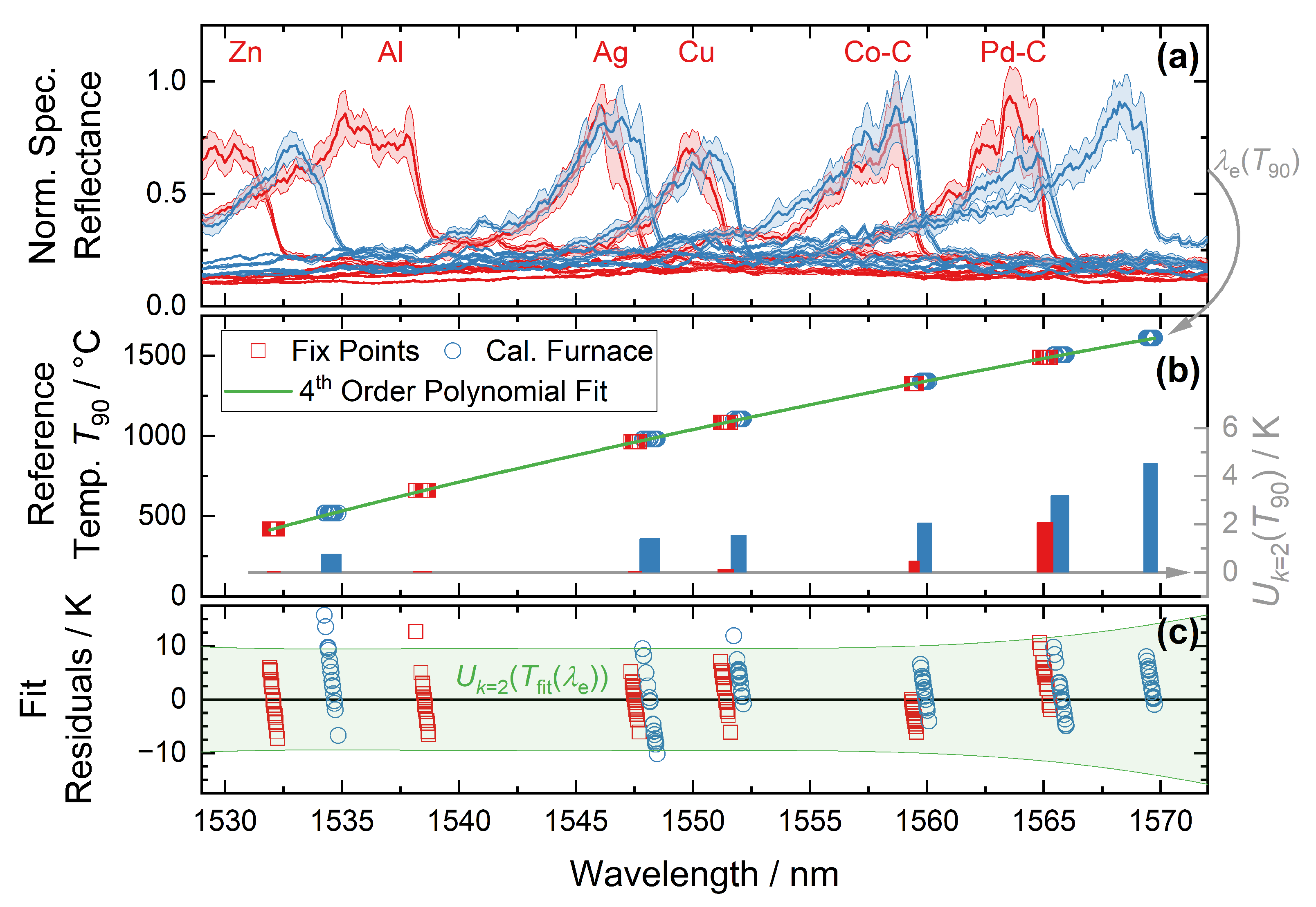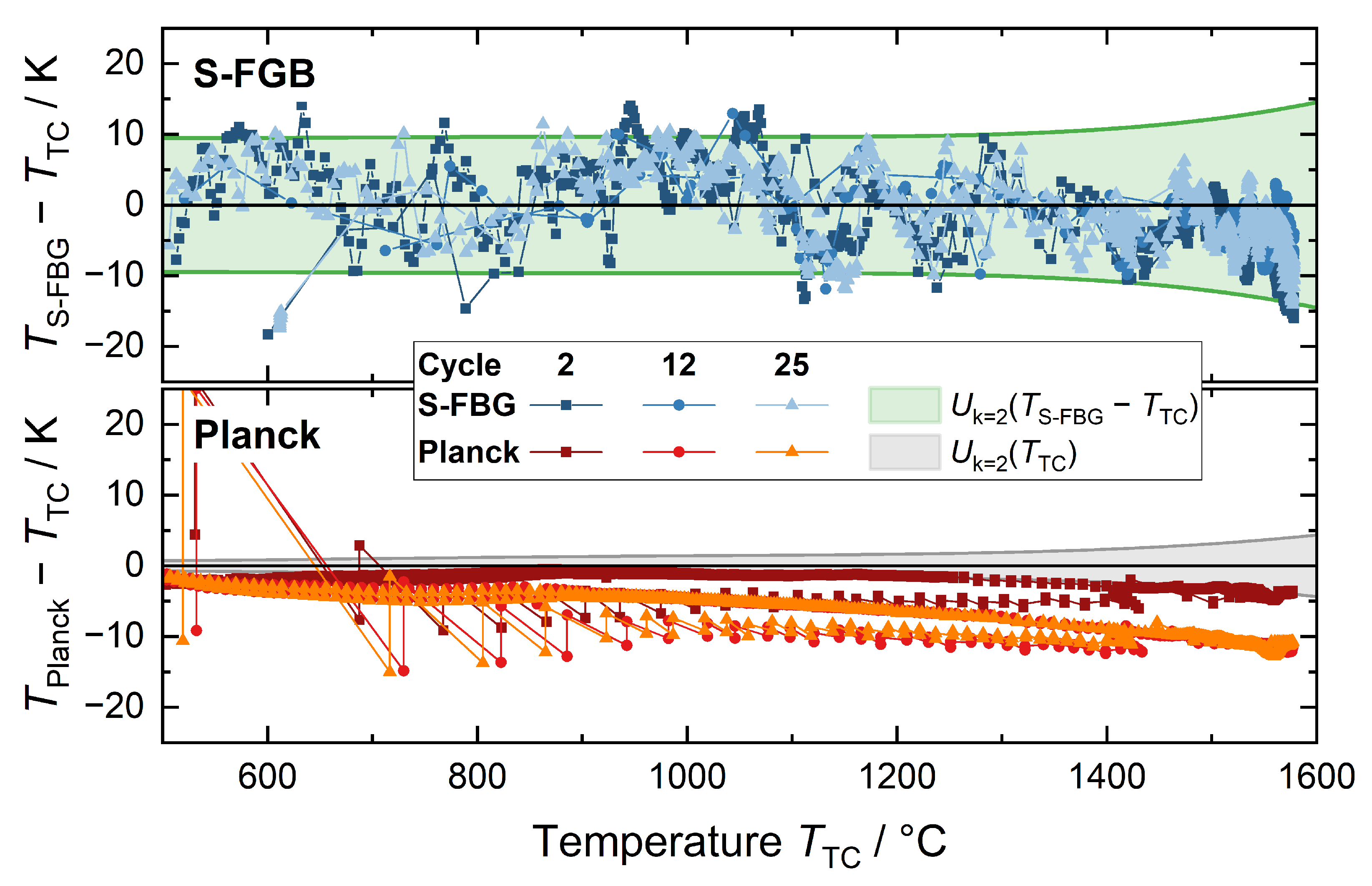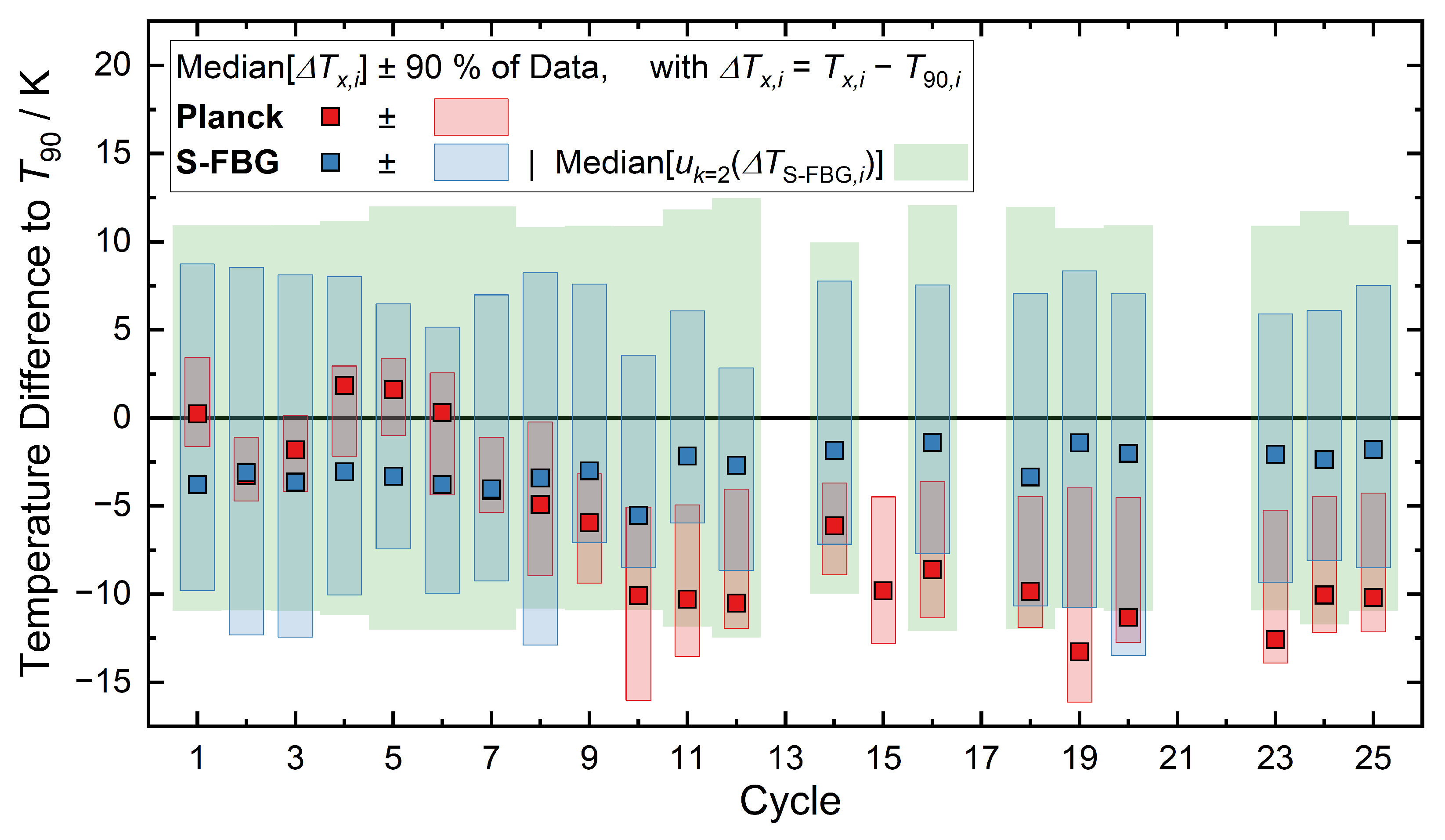1. Introduction
Decades of research has established fiber optics-based temperature sensors as viable tools in harsh environments and over long distances [
1,
2,
3]. Compared to electrical or electro-mechanical sensors, fiber sensors offer important benefits such as electrically passive operation, electromagnetic interference immunity, high sensitivity, and multiplexing capabilities [
1,
2]. They also provide a platform for a rich variety of sensing techniques. The fiber may be used as a light guide for signals generated at or near the fiber tip, such as blackbody or phosphor radiation. It may also be used as the sensor and signal guide, for instance, with Brillouin scattering-based thermometry or inscribed fiber Bragg gratings (FBG). FBGs as thermal sensors probe the change in optical pathlength as a function of thermal expansion and thermally induced change in the refractive index: by illuminating the FBG with a light source and detecting the reflection spectrum, it is possible to accurately track how the optical pathlength changes. Implementations of fiber optical sensors can be found in numerous applications, e.g., condition monitoring of power grid lines [
4], gas turbines [
5], or monitoring of composite pressure vessels [
6].
Silica fibers have been proven to provide reliable measurement data between −260 °C and 600 °C [
7,
8], but, for higher temperatures, their application has proven challenging. It has been shown that optical fibers show viscoelastic behavior under load starting at approx. 700 °C [
9]. The upper temperature limit is around 1000 °C [
10], where fused silica starts to devitrify, rendering the fiber unusable for optical applications. However, in vivo sensing in harsh environments, such as gas turbines [
5] and furnaces [
11], gasifiers [
12], or testing the fire resistance of fuel tank materials [
13], can easily reach significantly higher temperatures and pressures. Sapphire fibers are a promising alternative as they remain optically and mechanically stable at very high temperatures. It is possible, albeit challenging, to inscribe FBGs in sapphire fibers [
14,
15,
16,
17]. Habisreuther et al. [
11] previously reported using a sapphire FBG (S-FBG) sensor up to 1500 °C in an induction furnace. The sensor offered a temperature resolution of
K at a monitoring rate of 20 Hz [
11], but a quantification of the measurement uncertainty is still missing, as can be seen in [
11,
17]. The FBG was found to even withstand exposure to 1900 °C [
11]. Recent reports also show that single-mode sapphire fibers may successfully be used for the purpose, although their small diameter usually requires some form of cladding as mechanical support, which tends to limit the operational temperature range [
18,
19]. Hence, for the highest temperatures, one would typically be required to use a thicker sapphire fiber to ensure sufficient mechanical robustness. Unfortunately, a thicker fiber is optically harder to work with. With a typical operating wavelength around 1550 nm, a 100 µm diameter sapphire fiber will support multiple transmission modes. Since each mode will have different transmission characteristics, this leads to a wide and asymmetric peak in the reflection spectrum of a S-FBG. Moreover, the crystalline properties of sapphire enhanced the multimodal broadening of the grating reflection peak. Being a single crystal, the cross section is not perfectly circular, and this causes mode mixing effects and signal loss, especially for higher modes along the entire length of the fiber.
The combined effect smears the reflection peak in an asymmetric manner, with the consequence that data processing is more challenging [
17]. However, since the shape of the irregular peaks results from the optical and geometrical properties of the fiber, this pattern is stable and can be used for sensing applications.
One way to improve the peak shape is to change the optical properties of the fiber by applying a cladding, which is able to reduce the number of modes. However, this can be technically very challenging and, depending on the selected material, can limit the upper operating temperature [
20].
In addition to the S-FBG, it is possible to use the sapphire fiber itself as a blackbody thermometer. Dils [
21] first reported on a device using a sputtered iridium tip as a blackbody, whose thermal radiation follows Planck’s law and was transmitted through the fiber to a detection system at the low temperature end. It is also possible to use the fiber as a guide for thermal radiation from an external cavity, but this will complicate calibration and traceability. However, it opens up the possibility to utilize two fundamentally different physical processes to measure temperature in the same sensor: the thermal radiation and the FBG peak shift are physically independent signals which both carry information about the temperature.
In this paper, we integrated three methods of temperature determination in a single sensor using S-FBG, thermal radiation, and a conventional type B thermocouple. Using fixed-point cells, this sensor was calibrated and the temperature measurement uncertainty determined. We report on the results of embedding such a sensor in an industrial process at a silicon foundry at Elkem ASA Technology (Norway), where it was subjected to repeated heating and cooling cycles over a period of more than 3 weeks in a silicon re-solidification furnace. The thermocouple was also calibrated and used as a well-known in situ traceable reference for the optical methods.
Section 2 presents the background for the signal generation and subsequent data analysis for the sensor. An analysis on the reliable determination of the spectral position is shown.
Section 3 describes the manufacturing process of the hybrid sensor, with an overview of the entire readout system that was used. The characterization and calibration of the sensor elements is explained in
Section 4, including measurements in an induction furnace to assess the effect of scattered and absorbed light. Using the calibrated hybrid sensor, an industrial production process of silicon in a high-temperature furnace was monitored in
Section 5. The results of all three sensor principles (thermocouple, FBG, thermal radiation) are compared, and the stability of the sensors is determined. We summarize and discuss our findings in
Section 6, where we also offer our views on the outlook of implementing a data merging process to enhance robustness and precision of the temperature recording.
5. Results of the Field Trial in an Industrial Silicon Production Facility
5.1. Procedure and Context of the Field Trial
Subsequent to the calibration, the hybrid sensor was tested in a field trial at Elkem ASA Technology in Kristiansand (Norway). We monitored 25 cycles of the silicon resolidication. This step of the process takes around a day, which means a total sensor operating time of over 3 weeks. During this time, the hybrid sensor remained in the production furnace, which corresponds to continuous operation of about 500 h. Within each cycle, the furnace reaches temperatures up to 1600 °C to ensure an appropriate silicon purity. The furnace is first heated up to above the melting point of silicon (1410 °C). After a stabilization period, the furnace is filled with the approx. 1600 °C hot silicon melt. Afterward, a slow, controlled cooling of the melt to room temperature is carried out. Precise process control and, thus, monitoring of the temperature is essential to reduce material impurities of the silicon. Normally, this process is monitored by several thermocouples. Since our calibrated hybrid sensor is compatible with industrial process monitoring, it was possible to replace one of the regular sensors with our prototype. Comparable to the regular monitoring sensors, the hybrid thermometer is installed in a protective sleeve and is, thus, not directly exposed to the silicon in the furnace chamber. This protective sleeve is located near one of the heating elements of the furnace. The distance from the hot end to the cold end of the sensor is slightly less than 1 m. Since the furnace wall is actively cooled, the cold end of the thermometer is approximately at room temperature. As a result, the temperature gradients along the sensor can be quite high, especially when the heating elements are operated at full power.
Within the field trial, we treated the thermocouple as an in situ, known reference. After these 25 process cycles, the sensor was demounted and transported to PTB Berlin (Germany) for recalibration at fixed points to investigate its stability.
Figure 6 shows the temperature differences (for cycle 2, 12, and 25) between the optical methods (S-FBG and Planck) and the determined temperature by the thermocouple. The green area represents the expanded combined uncertainty of the S-FBG sensor and the thermocouple determined during their calibration, while the grey area represents the uncertainty of the thermocouple alone, for comparison. Each of the data points shown represents one measurement during a production cycle. Due to the holding times in the process at temperatures above 1400 °C, the number of data points for this temperature range is higher.
As explained in
Section 4.1, the calibration of the Planck emission was not possible due to the dependency of detected thermal radiation to the spatial thermal profile of the furnace. Therefore, the first cycle was used to fit the Planck data to the Sakuma-Hattori equation as described by Equation (
9). For this purpose, 20 data points covering the entire temperature range (500 °C to 1550 °C) are picked arbitrarily to adjust
S to
. The resulting fitted constants are
,
, and
, which were determined with a fitting uncertainty (
) below 4 K for temperatures above 800 °C. It should be noted that the exact values of the constants may change slightly depending on the selection of points. However, this has little effect on the fitting uncertainty, as this is determined by the uncertainty in the thermocouple calibration together with the scattering of points used for the fitting.
As can be seen in the upper part of the
Figure 6, most of the measured values are within the expanded combined uncertainty. A detailed analysis of all recorded data points (>100,000) shows that 96% of them are within this uncertainty. This fits well to the estimated 95% coverage of the expanded combined uncertainty and is a good indication for the correct estimation of the respective uncertainties.
Comparable to the calibration (see
Figure 5b), the determined temperature differences between S-FBG and thermocouple show a trend for temperatures above 1400 °C toward lower determined temperatures by the S-FBG. We think this is a combined effect of higher uncertainty of the thermocouple with increasing temperature and a sensitivity change of the S-FBG with temperature. Although this small trend is within the measurement uncertainty, it might be possible to reduce the effect in the future using additional calibration points (at higher temperatures) with ideally lower uncertainty.
The scatter of the S-FBG temperature can be explained by changes of the peak shape comparable to
Figure 1. Considering the 2
deviation (about 8 K) of our peak fit test for different mode propagation conditions (see
Table 2), the fluctuations are within the expected range. In this case, the change in peak shape has a different cause. The first reason is that the multimode profile of the S-FBG moves from detector pixel to pixel, which results in amplitude changes. Second, the propagation conditions (transmission losses) of the individual modes within the gradient index fiber change slightly with temperature.
In the comparison to the temperature determination with the S-FBG, the evaluation of the thermal radiation shows a smaller point-to-point variation, which could be defined as
for the difference
between the
k-th Planck and thermocouple value. It is for 95% of the values below 1 K (see
Figure 6). The remaining 5% are in parts of the industrial process with rapid temperature changes compared to the integration time, which can be explained as follows. Firstly, the integration time of the spectrometer varies between 1 s and 30 s (see
Section 3.3). Hence, during fast temperature changes, the average temperature during this period differs from the thermocouple reading recorded directly afterwards. Secondly, during these faster changes in the production process, the inhomogeneity of the thermal environment of the sensor is higher. For example, since the sensor was inserted through the heating elements, the temperature along the fiber is higher than at the tip during heating, which has a noticeable effect on the Planck signal (see
Section 4.1). In contrast to the S-FBG, a small hysteresis could be observed between furnace heating and cooling. This is probably mainly due to the changing temperature profiles during heating and cooling and the previously discussed dependence on the heating or cooling rate. Further, the the temperature calculated from the thermal radiation decreases in comparison to the thermocouple from cycle to cycle, as shown in
Figure 6. Hence, less thermal radiation is collected over time.
5.2. Stability and Repeatability
A summary of the results of all cycles of the trial are shown in
Figure 7, which includes the results of over 100,000 measurements. The squares represent the median temperature difference between the optical determined temperatures (S-FBG in blue, Planck in red) compared to the thermocouple. Because of the uneven distribution of the data points over the temperature range (see
Figure 6), the median provides a better representation of the typical values than the mean. As in
Figure 6, the green area represents the expanded (
) combined uncertainty of S-FBG sensor and thermocouple. Since this uncertainty varies during a cycle, the median of the data is shown here. The blue (S-FBG) and red (Planck) temperature ranges cover 90% of the data points in each cycle. Due to an error of the SLED power supply, the data of cycles 13, 17, 21, and 22 are not properly analyzable.
The S-FBG data exhibits a consistent scatter around the simultaneous thermocouple readings of around
K for 90% of the data points. It can be seen that the median deviation is always negative (
K to
K), which is consistent with the more positive residuals of the calibration fit for temperatures above 1500 °C (see
Figure 5). As indicated by the smaller red bars, the Planck data scatters slightly less (between
K and
K). It is evident that the S-FBG sensor remains stable, while the Planck sensor drifts between cycles 5 and 10, before stabilizing. While we have not investigated the cause of this in detail, a likely explanation is the buildup of a thin, opaque layer on the outer surface of the sapphire protection tube. The layer partly blocks radiation originating at the bottom of the thermometer well, and, hence, the amount of thermal radiation transmitted into the fiber changes.
From previous experience at Elkem, the likely substance is aluminium nitride, which tends to form slowly at exposure to the temperatures involved. Unfortunately, it was not possible to evaluate this assumption within the scope of the study, since a non-destructive analysis of the material composition of the surfaces was not possible.
In order to investigate the stability and repeatability of the S-FBG spectrum, the sensor was repeatedly measured at the Cu fixed point, whose absolute temperature is very well known:
°C.
Figure 8 shows the results in three different aging phases of the sensor:
We further investigated the effects of aging on the methods used to determine the spectral position of the S-FBG (as described in
Section 2.2).
Figure 8a shows the mean spectra of 35 acquired measurements together with the 1
error band. In addition, the mean position of the three determined wavelengths for
,
, and
are shown for the spectrum of the calibration. Each of the 35 spectra were obtained as described in
Section 4.3 by rotating the torsion-based mode mixer. It is evident that the spectral width of the S-FBG peak has decreased due to aging. This effect appears predominant at the short-wavelength flank of the S-FBG peak.
As discussed in
Section 2.1, the short-wavelength flank of the S-FBG spectrum represents modes with lower effective refractive index compared to the fundamental mode. These modes carry a higher proportion of their intensity in the outer region of the fiber, and the fact that they are suppressed indicates some form of structural change on or near the surface of the fiber.
The effect of these changes in the spectrum to the determined spectral position is shown in
Figure 8b for each method. The right axis gives the corresponding temperature difference before annealing and after on-site test, relative to the calibration. To convert the wavelength changes to temperature, the sensitivity determined from the calibration of 32 pm/K around the Cu fixed point was used.
Figure 8c shows the absolute change of
and the corresponding temperature (resulting from the calibration fit) compared to the fixed point temperature. The aging did almost not affect the long-wavelength edge detection, which demonstrates the robustness and reliability of the algorithm.
Table 7 shows the observed wavelength and temperature changes between calibration and follow-up measurement after the field trial. As shown in
Figure 8, the change in the short-wavelength flank mainly affects the centroid (
) with around 550 pm or 17 K drift caused by the on-site trial. In contrast to that, the S-FBG fit wavelength
(152 pm or 4.7 K) and the long-wavelength edge
(16 pm or 0.5 K) show higher stability.
shows the lowest drift and highest robustness, which supports its use for calibration and field measurement. Hence, the S-FBG signal has remained stable over the field measurements within the uncertainties of this comparison, and the same is true for the thermocouple.
This uncertainty at nearly constant temperature (
K) is much smaller than for the calibration of the sensor, since here an averaging over 35 spectra was performed so that even uncertainties below the resolution of the spectrometer (
pm) are possible. The standard error of the mean of the two measurement series and
contribute to the total uncertainty. The total uncertainty of the thermocouple can be assessed analogously to
Table 5, excluding the contribution of the residuals. The contribution of thermocouple wire inhomogeneity could not be neglected, as it may have changed during the field test.
6. Discussion and Conclusions
In this article, we have successfully demonstrated the metrological characterization of a high-temperature hybrid sensor using thermal radiation and calibrated S-FBG for process monitoring in harsh environments. The hybrid optical sensor additionally includes a type B thermocouple for comparison and process control.
We calibrated the S-FBG traceable to the International System of Units with an expanded measurement uncertainty of 10 K below 1400 °C and 14 K up to 1600 °C (see
Section 4.3). Changes of the peak shape due to variations of the mode propagation conditions were identified to be the main reason for the measurement uncertainty of the S-FBG-based temperature measurement. Using a manually controlled mechanical mode mixer, we were able to demonstrate a possibility to minimize this behavior. Further, we derived an expression for the long-wavelength edge of the S-FBG peak
and show that it is much more stable against mode variations (see
Section 2.2). We assume that, using the average of
over several spectra, the temperature uncertainty could be reduced by an order of magnitude toward the performance of the best high-temperature thermocouples. Another way to reduce the measurement uncertainty would be by reducing the number of modes (see
Table 1) of the sapphire fiber as described in [
12,
19,
20].
Furthermore, we were able to show that even long-term exposure to high temperatures (up to 1700 °C) has no negative influence on the measurement. Even after 3 weeks of repeated cycling up to 1600 °C, the S-FBG shows no significant drift. The difference between the readout before and after the field trial, analyzed at the Cu fixed point, was (0.5 ± 1.7) K and comparable to the thermocouple with (0.2 ± 2.1) K (see
Section 5.2).
In contrast to the S-FBG, this multimode behavior has only a minor impact on Planck-based temperature determination. However, this temperature determination using the thermal radiation of the furnace and the fiber itself requires an in situ calibration measurement. As shown in
Section 4.1, this is necessary due to the influence of the temperature profile along the sensor on its readout. When this calibration has been performed, the Planck temperature determination provides sub-Kelvin precision for slow (compared to integration time) temperature changes below, e.g., 1 K/min.
We assume that a combination of the complementary strengths of both optical sensing techniques potentially offers an even lower uncertainty. For this purpose, the temperature of the calibrated S-FBG could be used for the fitting of the thermal radiation temperature readout. The varying modes of the S-FBG can be treated as random noise for this purpose. In use, the Planck observations would be continuously recorded until the S-FBG has detected a sufficient temperature change (e.g., 200 K), after which the Sakuma-Hattori equation is fitted and also used to evaluate future temperatures. Whenever the temperature shifts far away from the original fitting range, a new fit is performed.
Based on our findings, we see a promising future for S-FBGs for high-temperature measurements. Methods are emerging that can make their accuracy competitive with thermocouples with the advantages of fiber-based sensing.
